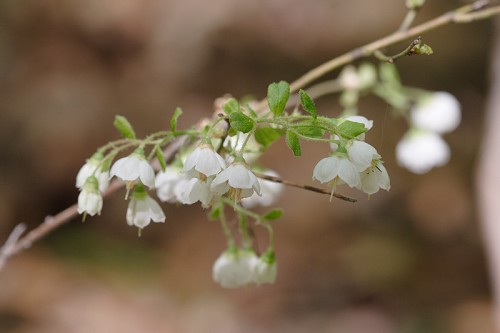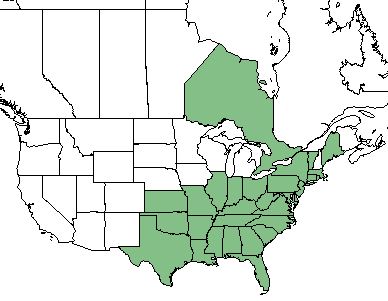Difference between revisions of "Vaccinium stamineum"
| Line 51: | Line 51: | ||
<!--==Diseases and parasites==--> | <!--==Diseases and parasites==--> | ||
| − | ==Conservation and | + | ==Conservation, cultivation, and restoration== |
''V. stamineum'' is listed as endangered by the Vermont Department of Fish and Wildlife Nongame and Natural Heritage Program.<ref name= "USDA Plant Database"/> | ''V. stamineum'' is listed as endangered by the Vermont Department of Fish and Wildlife Nongame and Natural Heritage Program.<ref name= "USDA Plant Database"/> | ||
| − | == | + | ==Cultural use== |
| + | |||
==Photo Gallery== | ==Photo Gallery== | ||
<gallery widths=180px> | <gallery widths=180px> | ||
</gallery> | </gallery> | ||
==References and notes== | ==References and notes== | ||
Revision as of 13:00, 8 June 2021
Common name: dwarf deerberry[1], Appalachian deerberry[1], Florida deerberry[1], whiteleaf deerberry[1], southern deerberry[1], common deerberry[1]
| Vaccinium stamineum | |
|---|---|

| |
| Photo by John Gwaltney hosted at Southeastern Flora.com | |
| Scientific classification | |
| Kingdom: | Plantae |
| Division: | Magnoliophyta - Flowering plants |
| Class: | Magnoliopsida - Dicots |
| Order: | Ericales |
| Family: | Ericaceae |
| Genus: | Vaccinium |
| Species: | V. stamineum |
| Binomial name | |
| Vaccinium stamineum L. | |

| |
| Natural range of Vaccinium stamineum from USDA NRCS Plants Database. | |
Contents
Taxonomic Notes
Varieties: Vaccinium stamineum Linnaeus var. 1; Vaccinium stamineum Linnaeus var. 2; Vaccinium stamineum Linnaeus var. caesium (Greene) D.B. Ward; Vaccinium stamineum Linnaeus var. sericeum (C. Mohr) D.B. Ward; Vaccinium stamineum Linnaeus var. stamineum.[2]
Description
V. stamineum is a perennial shrub of the Ericaceae family native to North America and Canada.[3]
Distribution
V. stamineum is found in the southeastern corner of the United States from Texas to Maine, as well as the Ontario region of Canada.[3]
Ecology
Habitat
V. stamineum proliferates in pinelands, xeric to submesic woodlands and forests, including pineoak/heath and shrub balds, pine flatwoods, and rock outcrops (unlike most species in Vaccinium, often on mafic, ultramafic, or calcareous rocks).[1] Specimens have been collected from planted pine in sand ridge, drying loamy sands, old field, slash pine scrub oak, longleaf pineland, mesic hammock, mixed hardwood forest, floodplain, hardwood hammock, and recently burned pineland.[4] V. stamineum responds negatively to agricultural-based soil disturbance in South Carolina coastal plain communities. This marks it as a possible indicator species for remnant woodland.[5][6] When exposed to soil disturbance by military training in West Georgia, V. stamineum responds negatively by way of absence.[7]
Vaccinium stamineum var. stamineum is an indicator species for the Clayhill Longleaf Woodlands community type as described in Carr et al. (2010).[8]
Phenology
V. stamineum has been observed to flower February through May and in July.[9]
Seed dispersal
This species is thought to be dispersed by consumption by vertebrates.[10]
Fire ecology
V. stamineum is not fire resistant but readily resprouts following fire[3] and is common in native pine communities treated with frequent fire.[11][12]
Use by animals
V. stamineum has medium palatability for browsing and grazing animals.[3]
Conservation, cultivation, and restoration
V. stamineum is listed as endangered by the Vermont Department of Fish and Wildlife Nongame and Natural Heritage Program.[3]
Cultural use
Photo Gallery
References and notes
- ↑ 1.0 1.1 1.2 1.3 1.4 1.5 1.6 Weakley, A. S. (2015). Flora of the Southern and Mid-Atlantic States. Chapel Hill, NC, University of North Carolina Herbarium.
- ↑ Weakley, A.S. 2015. Flora of the southern and mid-atlantic states. Working Draf of 21 May 2015. University of North Carolina at Chapel Hill, Chapel Hill, North Carolina.
- ↑ 3.0 3.1 3.2 3.3 3.4 USDA Plant Database https://plants.usda.gov/core/profile?symbol=VAST
- ↑ Florida State University Robert K. Godfrey Herbarium database. URL: http://herbarium.bio.fsu.edu. Last accessed: June 2014. Collectors: Robert K. Godfrey, Loran C. Anderson, Travis MacClendon, Karen MacClendon, Bian Tan, Scott Zona, Gary R. Knight, Richard S. Mitchell, K. Craddock Burks, D. L. Fichtner, R. A. Norris, R. F. Doren, K. M. Meyer, A. Townesmith, T. E. Smith, J. Beckner, W. G. D’Arcy, Annemarie Post, Cecil R. Slaughter, Sidney McDaniel, Leon Neel, R. Komarek, Richard Carter. States and Counties: Florida: Bay, Calhoun, Columbia, Escambia, Franklin, Gadsden, Jackson, Jefferson, Lafayette, Leon, Liberty, Madison, Marion, Okaloosa, Santa Rosa, Sarasota, St. Johns, Suwannee, Wakulla, and Washington. Georgia: Atkinson, Brooks, Grady, Taylor, and Thomas.
- ↑ Brudvig, L.A., E Grman, C.W. Habeck, and J.A. Ledvina. (2013). Strong legacy of agricultural land use on soils and understory plant communities in longleaf pine woodlands. Forest Ecology and Management 310: 944-955.
- ↑ Brudvig, L.A., J.L. Orrock, E.I. Damschen, C.D. Collins, P.G. Hahn, W.B. Mattingly, J.W. Veldman, and J.L. Walker. (2014). Land-Use History and Contemporary Management Inform an Ecological Reference Model for Longleaf Pine Woodland Understory Plant Communities. PLoS ONE 9(1): e86604.
- ↑ Dale, V.H., S.C. Beyeler, and B. Jackson. (2002). Understory vegetation indicators of anthropogenic disturbance in longleaf pine forests at Fort Benning, Georgia, USA. Ecological Indicators 1(3):155-170.
- ↑ Carr, S.C., K.M. Robertson, and R.K. Peet. 2010. A vegetation classification of fire-dependent pinelands of Florida. Castanea 75:153-189.
- ↑ Nelson, G. PanFlora: Plant data for the eastern United States with emphasis on the Southeastern Coastal Plains, Florida, and the Florida Panhandle. www.gilnelson.com/PanFlora/ Accessed: 29 MAY 2018
- ↑ Kirkman, L. Katherine. Unpublished database of seed dispersal mode of plants found in Coastal Plain longleaf pine-grasslands of the Jones Ecological Research Center, Georgia.
- ↑ Brudvig, L. A., E. Grman, C. W. Habeck, J. L. Orrock and J. A. Ledvina 2013. Strong legacy of agricultural land use on soils and undestory plant communities in longleaf pine woodlands. Forest Ecology and Management 310:944-955.
- ↑ Brudvig, L. A., J. L. Orrock, Damschen, C. D. Collins, P. G. Hahn, W. B. Mattingly, J. W. Veldman and J. L. Walker 2014. Land-use history and contemporary management inform an ecological reference model for longleaf pine woodland undestory plant communities. PLoS ONE 9:e86604. 10.1371/journal.pone.0086604